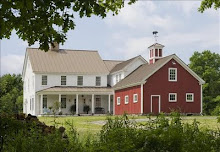 Stacks of reclaimed antique heart pine hardwood flooring lay in wait, acclimating to the interior environment, as carpenters finish beams overhead.
Stacks of reclaimed antique heart pine hardwood flooring lay in wait, acclimating to the interior environment, as carpenters finish beams overhead.
A rather elaborate competition is underway to determine the best hardwood floor finish for THE CONCORD GREEN HOME. The good news is that there are many healthier alternatives to the ubiquitous and toxic polyurethane used on most US floors today. Some methods are brand new, some old and time-tested, and still others are from across the pond (Europe is often well ahead of the US in the healthy house arena).
The winning finish will:
- BE SAFE – Most floor finishes used in US homes today, such as polyurethane, contain toxins that off-gas long after the powerful fumes dissipate
- SEAL – Lock in the pine and oak terpenes and aroma, which are common allergy triggers
- STAY - Remain inert when in contact with underfloor radiant heat temperatures of 90 degrees (particularly as we are finishing all sides to achieve goal A.)
- PROTECT - Provide durable protection from traffic and moisture
- MAINTAIN – Be easily maintained with minimal resanding, another process to avoid in a healthy house
Admittedly, there will be trade-offs to consider with the final selection. For example, most “living finishes” such as oil, score highly on most measures, but fail to seal in the wood allergens. Meanwhile, the polyurethane alternatives do require periodic resanding (although new dustless methods are now available). Others still have some volatile organic compounds (VOCs) upon application, but dissipate more quickly than standard polyurethane.
Our search needs to include winners for both antique reclaimed heart pine flooring and painted oak flooring.
Sampling process underway. Each product is applied and then cured for one week, prior to testing, which includes visual and textural inspection, aroma sniff test, off-gas (seal in glass/foil and then open to see if any off-gassing remains), compatibility between under- and top-coats, etc.
Here are the contenders:
Under Coat / Sealer
Zinsser Bull's Eye Shellac – an old standby that is highly toxic on application but cures fast and completely
Bonaseal – a low VOC sealer that cures quickly
AFM Safecoat Zero VOC Flat Paint – may have sufficient sealing properties to be used as undercoat for painted floors
Mythic Paint primer - also may have sufficient sealing properties to be used as undercoat for painted floors
All-In-One Finish (some can be used over Undercoat as well)
Rubio Monocoat - VOC-free, non-toxic natural oil finish with better than average durability
Vermont Natural Coatings – low VOC polymer coating made with recycled whey from Vermont dairy farms
AFM Safecoat Polyureseal - low odor, low VOC polyurethane
Bioshield Furniture and Floor Hardwax - "healthy living hardwax" made from natural oils, carnauba wax with lead-free dryers
WOCA - Zero-VOC oil from Denmark with natural matte appearance
Top Coat Only
Bona Traffic or Bona Strong - similar low VOC, low odor polyurethane alternatives that cure quickly
A big thank you to Rick Woodland of Terrene Sustainable Building Supply of Acton (one of our project sponsors). He has taken on the task of creating approximately 25 different samples for our test. He has also been a tremendous help in researching the chemical and performance properties of our various contenders. Thank you, too, to Steve Rush of Rush Quality Environments, Debra Lynn Dadd of Green Living Q&A, Leslie of Otterishly (MCS Safehouse), and the various product manufacturers for providing us with important information and guidance.
If you have any other wood finish suggestions, or experience with any of these products, please submit them via Comments section below soon!

































Lisa - in your research is the undercoat necessary to seal the flooring in general or just in radiant heat locations? I have been looking at the Vermont natural coatings, but have not done a mock up of how it looks yet.
ReplyDeleteTom
Hi Tom.
ReplyDeleteThe undercoat is not necessary in typical situations with some of these products, and certainly not required due to radiant heat use.
In this instance, we need to seal the terpenes and smells of the wood, which trigger allergies. This may be achieved with an undercoat, or perhaps with an all-in-one product, such as Vermont Natural Coatings. Hopefully, our testing process will make the right product and strategy clear.
Thanks for checking in.
Lisa
Lisa,
ReplyDeleteFor some reason your HTML is showing in your posts.
The faux beams look great even with messy jobsite!
Hi Concord Carpenter.
ReplyDeleteHmmm, thank you for alerting me. I am wondering if it shows up on pc's as I am working on a mac. Did it happen in today's post too?
Lisa,
ReplyDeleteI do not know about the Zinsser Bulls Eye Shellac but I do know that in most traditional shellac formulations the binder is ethanol (in some places known as corn liquor ;) . This type of shellac would never be described as "highly toxic" unless you were drinking it.
The US Green Building Council says this about shellac...
" Shellac’s natural resin binder, produced by the lac insect, is considered a renewable resource, and very few people are sensitive to the resin. Shellac uses ethanol, an alcohol solvent made from corn. During application, vapors from ethanol can irritate your eyes and respiratory system but they dissipate quickly as shellac dries.
Shellac can also be made with methanol, a powerful toxin also known as wood alcohol. This is uncommon, but you should check the MSDS."
To sum up: Most shellac formulations use ethanol are 100% renewable and at worst present a mild respiratory irritant when drying. Shellac formulations with methanol should not have been even considered as an option.
We just did a new addition to our home which I am using as my office. We used pine flooring (Key West bungalow design) - stained antique white and used an oil based polyurethane finish, which actually rose to the surface of the wood.
ReplyDeleteThe smell of pine is so strong your eyes and nose burn, headache and asthma like symtoms occur within 10 minutes.
So, we resanded and restained and used a water based poly. The strong pine smell is still there and all the irritations still persist. Help! I need to work..........short of pulling up the pine floors, what can I do now to seal the floors and get the allergies in check!!!
Hello Anonymous.
ReplyDeleteI am very sorry to hear of your issues with the pine flooring. Pine is very pungent, and can be quite difficult to fully seal. Each sample of pine wood can be different, and each person reacts differently.
That said, below are some options to consider. Of course, I strongly recommend testing before committing to the entire floor.
1. Paint the floors with ECOS non-toxic floor paint. You can search this blog (upper left corner) for more information on this fine product. We used 3 coats and found it to seal quite well.
2. Seal with ECOS non-toxic varnish. I have only tested this product on small samples, but found it to be very good. It has a slight odor (not bothersome to the sensitive folks here) for a few days, but then completely dissipates.
3. More drastic - Do one of the above, but pull up the boards and finish them on all 6 sides, and then reinstall. We did finish on all 6 sides in THE CONCORD GREEN HEALTHY HOME, so that there was no unfinished wood.
4. Most drastic - replace the pine flooring with something that does not trigger your symptoms, such as prefinished hardwood (be careful of which finishes are used), tile, concrete, etc. You can find more information on these options by searching this blog, as well as a great site called Green Q&A, founded by Debra Lynn Dadd.
Good luck. Please post back and let me know how things turned out. We all benefit from each other's experiences.
Thank you.
Lisa
Just before moving into an new little apt. with my new partner, he sanded and finished the old pine floors in the bedrooms. (I was out of town on a family medical emergency when he decided to do the floors.) After sanding, he used 100% pure tung oil, the first coat thinned with mineral spirits, then 5 more coats over the following week. That was nearly 6 weeks ago. He bought an Austin Healthmate Plus (Jr.) and it's been running constantly for almost a month and the outgassing and odor is still so bad I am coughing after 20 mins in the apt. Luckily I can stay on where I've been living, but I can't even go into "our" new place without getting sick. Now he's considering either trying another, bigger (pricier!) air purifier or, sanding down the floors to remove all the tung oil saturated wood and refinishing with something else. I'm really baffled because most of what I read on MCS related sites claims that tung oil has little odor and/or smell "nutty". The continuous, strong odor of the tung oil he used has be absorbed into all of his clothes and linens and upholstery and must be washed to reduce to stench. Do you have any helpful suggestions or advice? Thank you, B
ReplyDelete